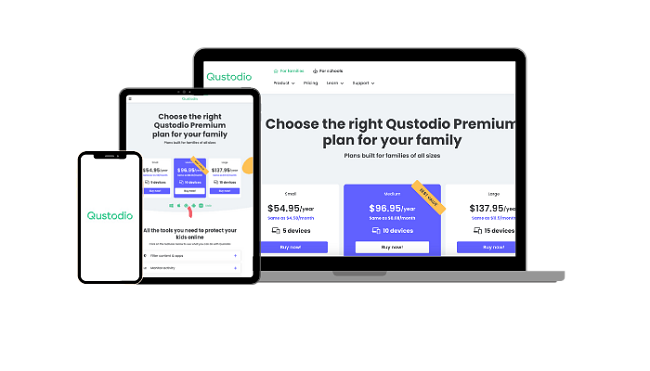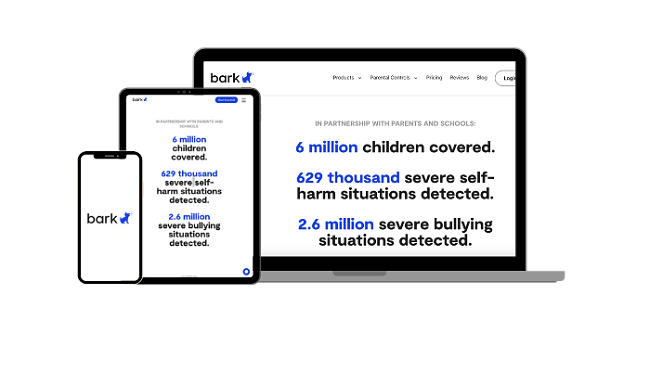How to See What Your Kids Are Doing Online in 2024
I didn’t think that seeing what my children do online would be very difficult. There are free tools for iPhone and Android, like Screen Time and Family Link, which are supposed to monitor and report to me on their online activity. However, after a few days, I noticed that my children spent a lot more time online than what was being reported on these free apps. I noticed the same thing with the browser extensions I tried on the computer.
When I asked my kids about this, they told me that they used a VPN, which bypasses the monitoring, and also showed me how easy it was for them to disable the monitoring apps.
I started researching effective tools that they couldn’t block so I could see what websites they visit. After testing more than 30 parental control apps, I found that Qustodio has the best tools for not only monitoring and reporting what they’re doing online, but also for filtering or blocking the web if I see that they’re acting inappropriately. Best of all, Qustodio has a 30-day free trial, with no credit card required, so you can try it yourself risk-free.
Try Qustodio Free for 30 Days!
Quick Guide: How to See What Your Kids Are Doing Online in 2024
- Get a parental control app: The best one I tested was Qustodio, with a feature list that included detailed reporting and it sent alerts when my child visited inappropriate or dangerous websites. You can try it risk-free for 30 days!
- Install the app on your child’s online devices: Create a profile for each child and download and install the app on their phone or computer. It will automatically track their online activities and upload the details to the parental dashboard.
- See what your kids are doing online: The parental dashboard syncs with the devices in near real-time, providing you with detailed information on what your child does online.
Why You Need a Premium Parental Control App to See What Your Kids Are Doing Online
There is no shortage of free apps that claim they can help parents monitor and track their child’s online activities. However, based on my research, these free apps are not worth the time it takes to download and install them. The majority of the apps that I tested which claimed to be free turned out to be “freemium” apps. All the good features, including tracking online activities, were locked behind a paywall. The free features that I got didn’t help me track any online activity, and I was constantly bombarded with ads and recommendations to upgrade.
The apps that claimed to be 100% free were also problematic. They lacked the capabilities to even monitor the browser history, let alone who my kids were interacting with or what apps they used. I also noticed that they were draining the device batteries and causing them to slow down.
There is also a trust issue. Free apps need to make money somehow, and it’s either through advertising or selling my child’s data to marketing companies. This is why I only trust a premium app from a reputable company. They have teams that are dedicated to developing and maintaining their apps, and since they charge a subscription fee, they don’t have to resort to ads or exploiting a child’s private data.
That’s not to say that all subscription-based parental control apps are good or trustworthy. After testing more than 30 parental control apps, I identified four that met my criteria in terms of performance, price, and privacy. Qustodio proved to be the best option. It tracks what my child does online, generates detailed reports, is compatible with Android, iOS, PC, Mac, and Kindle, and can be installed on up to 25 devices with a single subscription. You can test it for yourself risk-free with the 30-day free trial, which doesn’t require a credit card, and get a firsthand look at all its premium features.
Try Qustodio Free for 30 Days!
The 5 Best Parental Control Apps for Seeing What Your Kids Do Online in 2024
1. Qustodio: Tracks Browser, Search, and App Use History and Generates Detailed Reports
- Activity timeline details all online activities
- Monitors YouTube and tracks search and viewing history
- Tracks which social media apps are used
- Comprehensive web filter blocks inappropriate sites
- Try Qustodio free for 30 days – no credit card required!
Qustodio claims to have comprehensive monitoring and tracking features, however, I’ve seen enough apps that make similar statements and can’t back them up. I tested the app on my son’s Android, and quickly saw that this app was different from the others I’ve tested.
As soon as the installation was complete, it started running in the background, monitoring all of my son’s online activities. The data is uploaded to the dashboard, which I can access from an app or log in from any browser. The dashboard’s homepage has quick summaries of all websites that the child tried to access but was blocked by the web filter, which apps are most often open, the most common search terms used on major search engines, and detailed reports on YouTube activity.
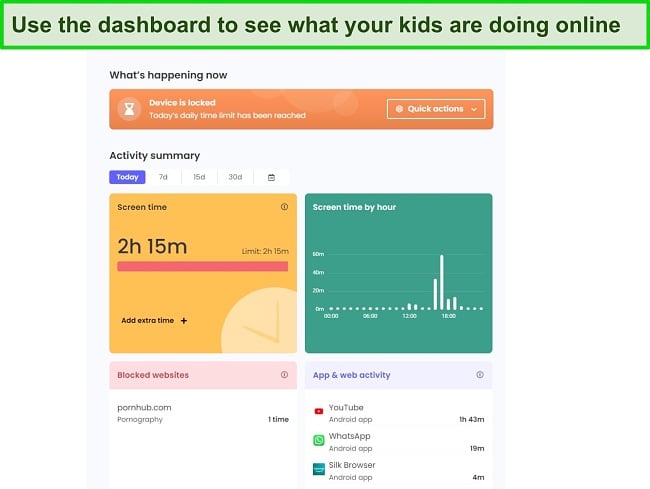
The next step is to click on the Timeline on the left-hand menu bar. This opens a detailed chronological breakdown that combines all phones, tablets, and computers on the account. The timeline shows a timestamp and the amount of time the app was in use. Most importantly, this is where you can see the browser and search history.
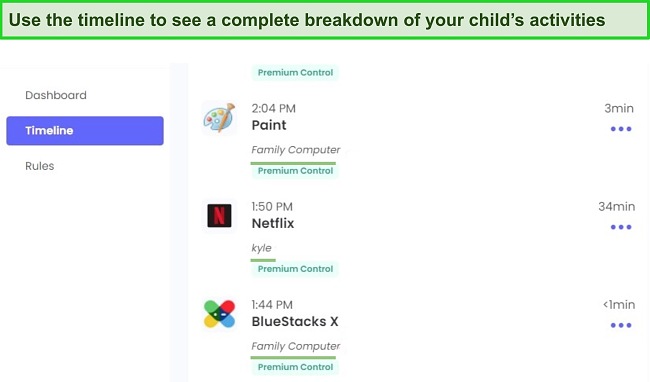
I like that there is a filter option, which allows me to remove unnecessary activities so I can focus on monitoring his online activity. The filter options are all activity, web activity, app activity, searches, calls & messages, and locations. If all I want to see are Google or YouTube searches, I turn on the Searches filter, and all other activities are hidden from the timeline.
One thing that separates Qustodio from other apps I tested is that in addition to monitoring online activities, it also has the necessary tools to take action. I can block the browsers, apps, and even specific URLs. There are also tools that help me with monitoring such as a web filter with over 30 categories, SafeSearch, and YouTube Restricted Mode to block inappropriate and dangerous websites, searches, and videos.
Qustodio has a 30 day free trial, with no credit card needed, which is plenty of time to install the app on your child’s device and get an inside look at what they’re doing online. It’s compatible with Android, iOS, PC, Mac, Chromebook, and Kindle, and can monitor up to 25 devices with a single license. This was important, because it meant that I only needed one account to monitor all my children.
Try Qustodio Free for 30 Days!
2. mSpy: Records Screenshots and Keylogger to Track All Online Actions
- Monitors popular social media and messenger apps
- Records browser history, saved bookmarks, and email
- Add a list of keywords that will trigger an alert
- Try it risk free with a 14-day money back guarantee
I could tell right away that mSpy was a different type of parental control app than Qustodio. Instead of creating web filters and setting screen time limits, its focus is on tracking everything that happens on the device.
Once the app is installed on the Android or iOS device, it automatically starts taking screenshots, both at timed intervals and each time a new app or website opens. The screenshots are then uploaded to the dashboard, with a timestamp, so I can see exactly what my kid is doing online.

The keylogger is another really helpful tool for knowing what my child is doing online. It saves everything that my son types on his phone, including deleted messages, online logins, passwords, and searches. While this can seem difficult to monitor, especially when a kid is always on the phone, mSpy does a good job of indicating which app each keylogger entry is from. It makes it easier to manage if you know what you’re looking for.
mSpy also tracks the browser history and bookmarks on most browsers. It’s an easy way to see what my child is doing online and what his favorite websites are. It also monitors more than 10 popular social media and messenger apps, like Facebook, Snapchat, Instagram, and WhatsApp. The difference between this monitoring tool and the keylogger is I can see incoming and outgoing messages, while the keylogger only shows me what my son types.
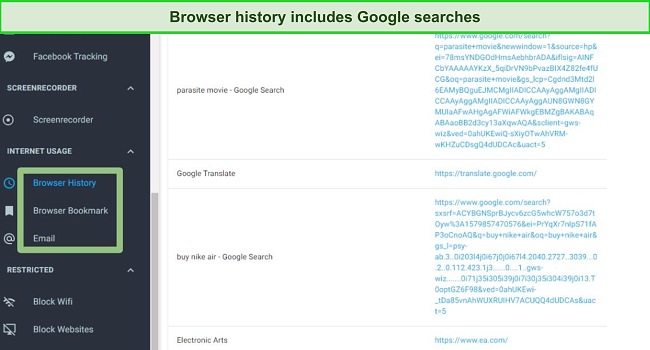
mSpy collects so much data, it can be difficult to scroll through all the screenshots, keylogger entries, and social media interactions. That’s where the keyword tracker feature becomes so valuable. It allows me to create a list of words or phrases that are either used in general or with specific apps, and if my son types them in the phone, I’ll get an alert. This is a feature that I haven’t seen with most other monitoring apps that I’ve tested.
While I can see everything my son does online with mSpy, it’s only compatible with Android and iOS and monitors just one device. If you’re not sure if this is the right tool for you, you can create a free account and test it for yourself, using the 14-day money-back guarantee. It’s important to note that this isn’t a “no questions asked” policy; I had to give a reason why I was canceling my account, before I could receive a full refund.
Try mSpy Risk-Free for 14 Days
3. Norton Family: Activity Reports Show Search and Browser History
- Norton browser or extensions track online actions
- Generates reports on app and web use
- Try it free for 30 days!
Norton Family is a good option for seeing what your kids are doing online, but if they’re on a mobile device, you’ll need them to use the Norton Family browser. This was met with some resistance at my house, but I was able to block all other browsers, leaving my kids with no choice but to use the Norton browser. For monitoring what the kids are doing on the PC, I was able to install a browser extension, which let me see what they were doing.
I was able to access the parental dashboard from any browser or through a mobile app on my phone. It gave me a clear breakdown of what my kids are doing on the web, which apps they use, search terms, and videos viewed.
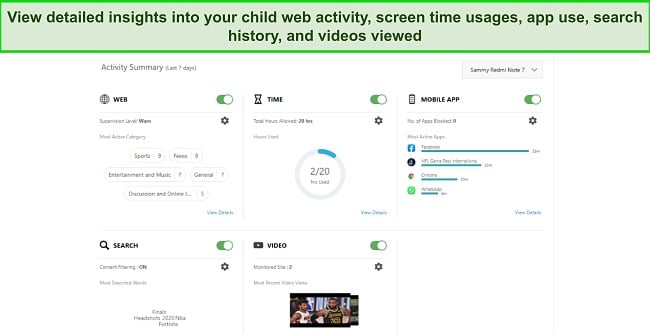
In addition to showing which websites my son visits, it also shows the website categories that he goes to. I found this helpful for two reasons:
- Just knowing the URL doesn’t always tell me what the website is about, and whether it’s something I should be concerned about.
- The Norton Family web filter has over 40 categories. If I see that my son is going to websites with a category tag I don’t approve of, I can adjust the filter to block it from opening.
While Norton Family doesn’t show me the details of what my child is doing on each app or who they’re chatting with, like mSpy does, at least I know the apps that he uses. It also gives me the option to block the apps, which is helpful when I see that my son is on YouTube, Snapchat, or TikTok for several hours each day.

Norton Family doesn’t limit the number of devices it can monitor per account. It’s compatible with Android, iOS, and PC, but doesn’t have a version for Mac. Norton Family recently added a 30-day free trial, which is plenty of time to install it on your child’s phone or computer and monitor their online activities.
Try Norton Family Risk Free for 60 Days!
4. Bark: Uses AI & Machine Learning to Monitor For inappropriate and Dangerous Behavior
- Uploads screenshots to dashboard when it detects inappropriate behavior
- Monitors over 30 social media apps, email servers, and browsers
- Try Bark free for 7 days!
If your only concern is seeing what your kids are doing online when they’re acting inappropriately or dangerously, then Bark has the tools that you need. Instead of sending a bunch of alerts detailing everything that your child is doing online, alerts are only added when it detects online activities that parents should know about, such as trying to visit adult websites and inappropriate social media or email interactions.
It uses AI and machine learning to monitor chats, images, and DMs on social media, email, and Chrome and Edge browsers. There are 17 categories, and I could adjust the sensitivity levels, such as sexual content, drugs and alcohol, weapons and violence, self-harm and suicide ideation, and cyberbullying, to reduce unnecessary alerts.
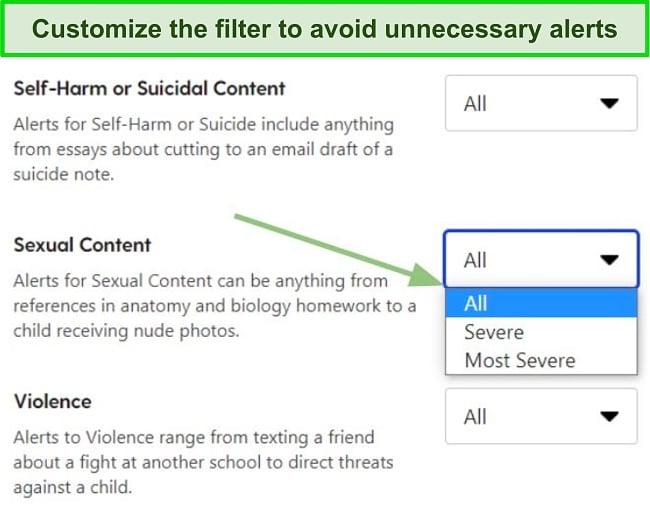
When Bark detects something that triggers its sensors, it adds an alert to the dashboard. The alert consists of a screenshot, category tags so I know why the content was flagged, the app or website where the alert was detected, and, when applicable, the person the child was interacting with.
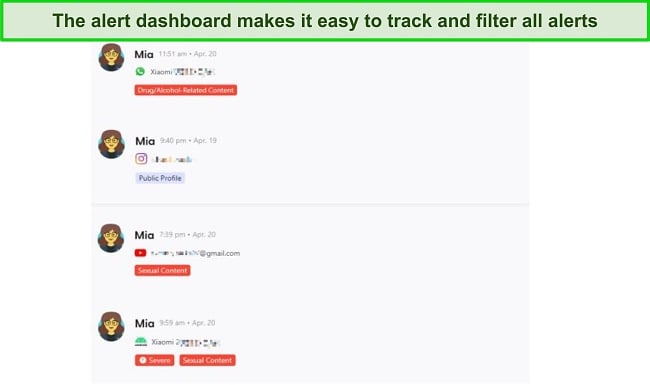
Bark also has a traditional web filter that monitors web content and blocks and reports on any website that the kid tries to visit. Unfortunately, there is no browser or search history, which is why you can only see what your kid is doing online if they cause an alert.
The parental dashboard has an Insight section, which provides some general information about how my son acts when he’s online. It detects the tone of his messages, lets me know what kind of websites he visits, the people he communicates with the most, and it shows how many pages or apps it analyzes and the number of alerts it detected. If I see that there’s a large percentage of alerts when he’s online, I know that there is a problem that needs my attention. On the other hand, if I see that based on the amount of time he’s online, it only triggers an alert every now and then, I can relax knowing that he’s behaving appropriately and isn’t having any issues with his online life.
Bark has a 7-day free trial, although I did need to enter my payment information to activate the account, but I was not charged. This is plenty of time to connect Bark to your child’s apps, email, and browsers and see if there are any troublesome trends or dangerous people that they’re communicating with online.
What About Google Family Link for Android?
Google Family Link is a perfect example of the saying “you get what you pay for.” The app was developed by Google, who owns Chrome and Android, and despite that, the only information I can see is what apps my child uses. It doesn’t show me a Google search history, what websites were opened, or what videos were viewed on YouTube – all of these are Google apps.
Honestly, even if it did track my child’s online activities, it wouldn’t be a viable option. That’s because Family Link gives kids over the age of 13 the option to turn off supervision, without even alerting the parents when this happens.
Family Link is just another Google app that collects data from users to build a profile that it can use to target ads. Instead, you can download Qustodio and take advantage of the 30-day free trial, which has multiple safeguards in place to prevent your kids from disabling or bypassing the tracking and monitoring tools.
What about Screen Time for iOS and Mac?
Screen Time is another example of a company that releases a free parental control app, but it’s not the focus of the company. It really feels like it’s there just so Apple can say it’s there. Generally speaking, the app is pretty easy for any kid with internet access to bypass.
But, when it comes to tracking online activities, the child doesn’t need to know any hacks as long as they don’t use the Safari browser. While Screen Time will list any website that is opened on Safari, if the child is on Chrome, Firefox, or any other browser, it won’t record any data.
How I Tested and Ranked the Best Parental Control Apps for See What Kids Are Doing Online
I started by testing different methods, such as placing the computer in the living room and setting “no tech zones” so my kids couldn’t hide what they were doing. However, these only worked if I was at home and paying attention to what the kids were doing.
Next, I installed several free parental control and monitoring apps on my kids’ phones. However, this quickly proved to be a waste of time. The apps didn’t really monitor what my kids were doing, just providing very basic app information, if at all. Combined with no uninstallation protection, they didn’t give me any help at all in seeing what my kids were doing online.
Finally, I started purchasing premium parental control apps and installing them on their phones and computers at home. I tested over 30 apps to see if there were any that worked and what kind of information they provided. Here are some of the main factors that I considered when ranking the top parental control apps:
Ease of Use
I don’t want an app that is difficult to set up and use. The ideal app doesn’t require rooting the phone, and works in the background, collecting the data I need. I also want to be able to view the information from anywhere. The dashboard needs an easy-to-use interface, so I can find the information I need quickly.
Monitoring capabilities
I don’t need to know how long my son was on Chrome or when he used specific apps, which is what most apps showed me. I need detailed reports, which can include the browser history, who my child was interacting with, or screenshots of the online activities.
Web filter
A good web filter is extremely helpful when it comes to seeing what your kids are doing online. It saved me from wasting time scrolling through links, looking at screenshots, and reading chat transcripts.
Additional features
Knowing what my child is doing online is just the first step. I want to be able to take action if I see things that I don’t like. This includes setting screen time limits, blocking apps, and monitoring phone calls and messages.
Free trial and pricing
I tested the free trials or money back guarantees to ensure that they are real, and I received a full refund. When it comes to pricing, I don’t just look at the cost per month, but the overall value that the app provides. Many times, the cheapest option was so cheap because it had limited features.
After testing the apps, it was clear that Qustodio is the best choice for seeing what my kids are doing online. It gave me detailed information, in an easy-to-read timeline, which lets me see their patterns of how they use their phone and computer. It’s also compatible with all major platforms and can be used on up to 25 devices at once. There is also a 30-day free trial, with no credit card required, so I could test all the premium features and see exactly what my kids are doing online.
Try Qustodio Free for 30 Days!
FAQ
Are there any free apps I can use to see what my kids are doing online?
What type of online activity can I see with a parental control app?
Every app is different and has its own pros and cons. mSpy takes screenshots of everything your child does online but can only be used on one device at a time. Norton Family does a good job monitoring browser history, but the kids need to use the Norton Family Browser. Bark only shows alerts when its monitoring sensors are triggered.
However, Qustodio is the best option because it does it all, without these limitations. It lets me know what websites my children use, the videos they watch, monitors phone calls and messages, and which apps they’re using. Best of all, it has a 30-day free trial, so you can test it for yourself risk-free.
Can my kids disable or bypass the parental control apps?
Only a Premium Parental Control App Can Let You See What Your Kids Are Doing Online
I was really hoping that Screen Time and Family Link would be able to give the insights I needed to see what my kids were doing online. Unfortunately, that wasn’t the case, and my kids had no problem hiding their online actions. The free apps were much worse, between the useless monitoring, slowing down the computer, draining the batteries, and privacy concerns, they weren’t worth the time it took to download and install the app.
A premium parental control app is the only viable option that I could find. The 4 best ones that I found, each have different methods for reporting on the child’s online activities and have uninstallation protection, making it difficult to bypass. Among the 4, Qustodio is the most comprehensive and best option for seeing what my kids are doing online. You don’t have to take my word though, Qustodio has a 30-day free trial with no credit card required, so you have plenty of time to test it out for yourself.

